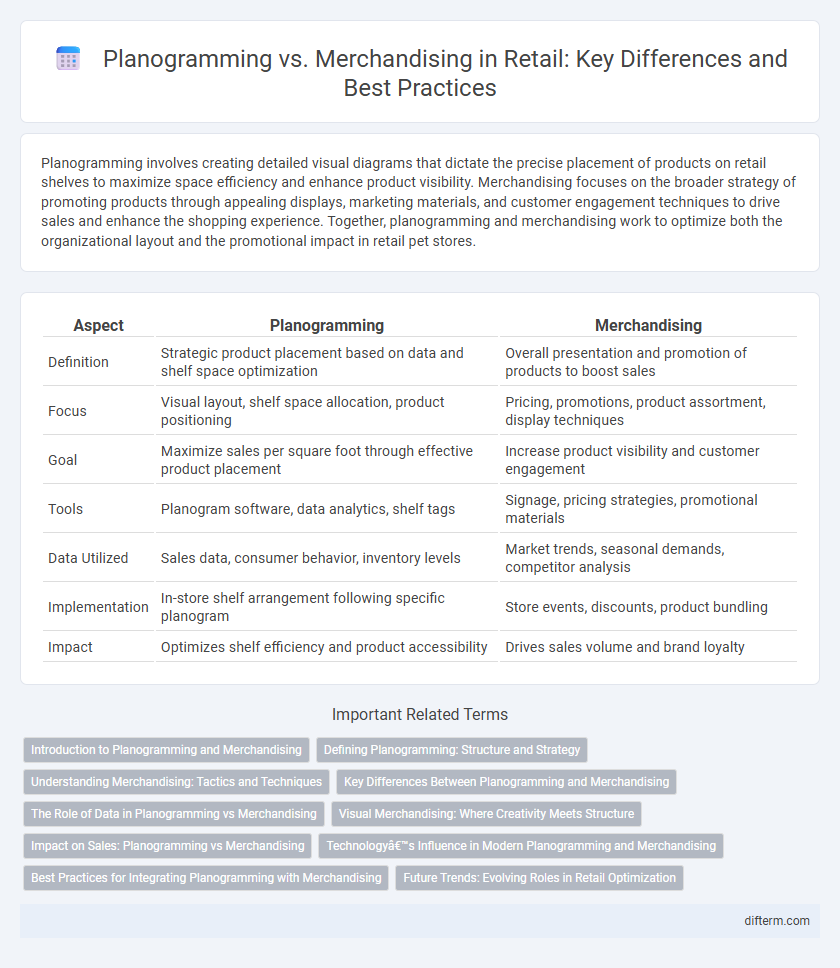Planogramming involves creating detailed visual diagrams that dictate the precise placement of products on retail shelves to maximize space efficiency and enhance product visibility. Merchandising focuses on the broader strategy of promoting products through appealing displays, marketing materials, and customer engagement techniques to drive sales and enhance the shopping experience. Together, planogramming and merchandising work to optimize both the organizational layout and the promotional impact in retail pet stores.
Table of Comparison
| Aspect | Planogramming | Merchandising |
|---|---|---|
| Definition | Strategic product placement based on data and shelf space optimization | Overall presentation and promotion of products to boost sales |
| Focus | Visual layout, shelf space allocation, product positioning | Pricing, promotions, product assortment, display techniques |
| Goal | Maximize sales per square foot through effective product placement | Increase product visibility and customer engagement |
| Tools | Planogram software, data analytics, shelf tags | Signage, pricing strategies, promotional materials |
| Data Utilized | Sales data, consumer behavior, inventory levels | Market trends, seasonal demands, competitor analysis |
| Implementation | In-store shelf arrangement following specific planogram | Store events, discounts, product bundling |
| Impact | Optimizes shelf efficiency and product accessibility | Drives sales volume and brand loyalty |
Introduction to Planogramming and Merchandising
Planogramming uses visual diagrams to strategically position products on retail shelves, enhancing customer navigation and boosting sales through optimized product placement. Merchandising encompasses broader tactics including pricing, promotions, and in-store displays aimed at improving brand visibility and driving consumer purchases. Together, they form essential components of retail strategy, ensuring inventory is both appealing and accessible to target shoppers.
Defining Planogramming: Structure and Strategy
Planogramming involves creating a detailed visual representation of product placement on retail shelves, emphasizing optimal space utilization and customer flow to maximize sales. It structures product categories and shelf arrangements based on sales data, consumer behavior, and inventory levels to drive strategic decisions. Effective planogramming ensures consistent brand presentation and supports merchandising strategies by aligning layout with marketing goals and shopper needs.
Understanding Merchandising: Tactics and Techniques
Merchandising encompasses strategic tactics such as product placement, promotional displays, and visual appeal to influence consumer purchasing behavior effectively. Techniques include optimizing shelf space, utilizing signage to attract attention, and arranging products based on buyer psychology to maximize sales. Retailers leverage merchandising to create engaging shopping experiences that drive customer satisfaction and increase profitability.
Key Differences Between Planogramming and Merchandising
Planogramming precisely maps product placement using visual diagrams to optimize shelf space and improve inventory management, while merchandising involves broader strategies including product selection, pricing, and promotional displays to boost sales. Planogramming emphasizes data-driven layouts and spatial organization, enhancing shopper navigation and category performance. Merchandising focuses on brand presentation and marketing tactics, aligning product assortments with consumer demand and seasonal trends.
The Role of Data in Planogramming vs Merchandising
Data-driven insights enhance planogramming by optimizing shelf space allocation and product placement based on consumer behavior and sales trends. Merchandising leverages data to develop promotional strategies and tailor inventory assortments aligned with market demand and seasonal fluctuations. Effective use of data analytics in both planogramming and merchandising drives improved customer experience and maximizes retail profitability.
Visual Merchandising: Where Creativity Meets Structure
Visual merchandising merges creativity with structure, transforming retail spaces into engaging and persuasive environments designed to influence customer behavior. Planogramming, a data-driven tool, supports this by strategically organizing product placement based on sales analytics and consumer insights. Together, they optimize shelf space and enhance aesthetic appeal, driving both brand identity and revenue growth.
Impact on Sales: Planogramming vs Merchandising
Planogramming optimizes product placement based on data-driven consumer behavior insights, leading to increased shelf visibility and higher sales conversion rates. Merchandising enhances the overall shopping experience through strategic promotions and visual appeal, driving impulse purchases and repeat business. Combining both planogramming and merchandising strategies maximizes sales impact by ensuring products are both attractively presented and strategically positioned for customer engagement.
Technology’s Influence in Modern Planogramming and Merchandising
Technology has revolutionized planogramming by enabling retailers to create precise, data-driven shelf layouts through AI-powered software, which optimizes product placement based on consumer behavior analytics. Digital planogram tools integrate real-time sales data and inventory management, enhancing merchandising decisions and improving product visibility and turnover. Advanced technologies like augmented reality (AR) and machine learning are increasingly employed to simulate store environments and predict merchandising outcomes, driving higher efficiency and customer engagement.
Best Practices for Integrating Planogramming with Merchandising
Integrating planogramming with merchandising enhances product visibility and optimizes shelf space utilization, boosting sales and customer satisfaction. Employing data-driven planograms aligned with merchandising strategies ensures consistent brand presentation and inventory management across multiple retail locations. Leveraging retail analytics to refine planogram adherence and dynamically adjust merchandising tactics results in improved stock turnover and enhanced shopper engagement.
Future Trends: Evolving Roles in Retail Optimization
Planogramming is becoming increasingly data-driven, leveraging AI and machine learning to optimize product placement with precision, enhancing shopper experience and sales. Merchandising roles are evolving beyond traditional product displays to encompass personalized marketing strategies and real-time inventory adjustments powered by advanced analytics. The integration of virtual reality and augmented reality tools is set to revolutionize both planogram execution and merchandising, providing immersive insights and dynamic store layouts that adapt to consumer behavior trends.
Planogramming vs Merchandising Infographic

 difterm.com
difterm.com